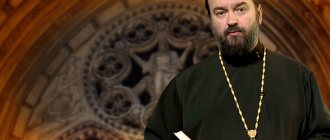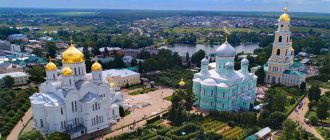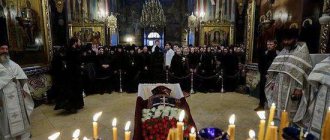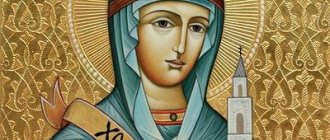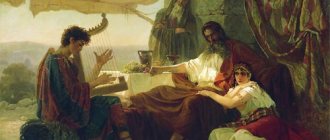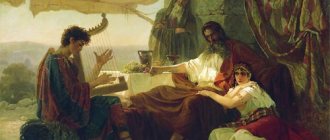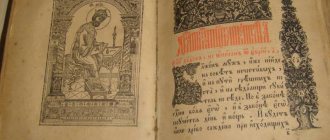India's population is 1.3 billion people. And this means that every sixth person on planet Earth lives in this country. 2.4 billion people - about the same number of people who consider themselves Christians. This is approximately every third earthling. A huge number of people that is difficult to imagine. And it can hardly be assumed that these communities do not intersect anywhere.
I recently watched a video of a celebration in a Christian community in India. I watched how they prayed and rejoiced: how smart they were, how they sat on the carpeted floor of the room that served as their temple, and sang their hymns, accompanying them with the sounds of tambourines, drums and clapping of hands. I saw how different what was happening from what happens during our services. It is so different that if I had not been warned that what I was seeing was directly related to Orthodoxy, I would not have even thought about it. But I look at these amazing people and once again I am convinced that no matter how different we may seem, there is One who gave us the opportunity to call each other brothers and sisters.
These are Catholics. Yes, they are also available in India
First Christians of India
It is a generally accepted fact that Christianity came to India long before it spread throughout most European countries. However, the question of who brought the Good News here is considered open by many.
Tradition connects the appearance of the first Christians in India with the Apostle Thomas. It is believed that the apostles distributed the territories for preaching by lot, and India fell to Thomas. In 52 AD he arrived at Kodungallur on the Malabar coast (now in Kerala), preached there and founded several Christian communities. According to this version, the apostle ended his earthly life as a martyr - he was killed by a brahman (a representative of the highest stratum of Hindu society, possibly a clergyman) and buried on the site of the current Catholic Cathedral of St. Thomas in Madras.
Saint Demetrius of Rostov, who also connects his mission with the territory of India, offers a more specific version of the martyrdom of the apostle: Thomas was killed by the local ruler Muzdius because his preaching brought discord into the royal family: Muzdius’s wife refused marital communication with her husband. Be that as it may, Christians of the Apostle Thomas believe that he was the first preacher of the Gospel in India. By the way, their second name - “nasrani” - supposedly comes from the word “notzrim” (“who are from Nazareth” in Hebrew, after the hometown of Jesus Christ). In the Middle East, this word was used to refer to Christians.
Ancient historians and church writers such as Gregory the Theologian and Jerome of Stridon had no doubt that the first preacher of Christianity in India was the Apostle Thomas. But modern historians associate the emergence of Christianity in India with the name of another Thomas - Kansky (in Malayalam - Knai Thomman). This merchant from Edessa, with the blessing of the Patriarch of Antioch, in the middle of the 4th century went on a sea voyage with 72 Christian families and Bishop Joseph and landed on the Malabar coast, fleeing the persecution of the Persian king Shapur II, who pursued an anti-Christian policy.
There are almost no images of Thomas Kanait on the Internet. This is the only thing I could find
Researchers believe that this man was “confused” with the Apostle Thomas, and the result of this confusion was the special treatment of the latter by Indian Christians. And this time gap of 300 years between the activities of the Apostle Thomas and Thomas of Cana gives reason to say that not a single church in India can consider itself the direct heir of the Apostle, because all this time there was no priesthood in it. One way or another, by the time of the first contacts with European Christians and the Great Geographical Discoveries, the Christian communities of India had been in canonical unity with the Syrian Church for almost a thousand years.
Alfred the Great
To whom is the truth revealed?
Later that day I also talked to an Indian man who is also married to a Russian. From him we were able to learn some interesting facts about Catholic and Protestant missionary work in India. For example, he says that the famous Mother Teresa made it clear to the sick that she would help them only if they accepted Catholicism, and everyone in India allegedly knows about this and therefore does not respect her. Perhaps this is just “Hindu propaganda,” but perhaps there is also an echo of some realities here that are not reflected in the image of this woman created in the West.
My interlocutor said that now Protestants preach this way, including among Indian Catholics, offering them help in exchange for accepting the faith, and that those who convert from Catholicism to Protestantism must step on the icon of the Mother of God. I asked with surprise whether this really happens these days, and he confirmed that this happens now, but not in large cities, but in poor villages.
It was also interesting to learn the Hindu interpretation of the fact that the remains of Francis Xavier were preserved, which local Catholics clearly perceive as a miracle of God. The Hindus say that when Xavier landed in these places, a certain Brahmin cursed him and sprinkled him with special enchanted water, and as a result of this curse, Xavier’s body cannot decompose and be buried like the bodies of other people.
However, Saint Nicholas of Serbia, who visited India and fell in love with the Indians very much, expressed the hope that one day they would convert to Orthodoxy, and that Orthodoxy would bring them liberation from everything that torments India to this day, as well as everyone who lives without Christ. God grant that this really happens someday. Unfortunately, as Saint Nicholas of Serbia noted, Catholics and Protestants have greatly discredited Christian missionary work in the eyes of local residents, and now it is even officially prohibited in almost all states of India.
To read The Church honors the memory of the holy noble Tsarevich Demetrius of Uglich and Moscow
On the last evening, I allowed myself to rest a little and just walk around the village, and Father Alexey spent the rest of the night talking with the people who had come for the farewell dinner. I think such a long and deep communication with the priest in an informal setting meant a lot to them.
First contacts with European Christians
In the 9th century, Alfred the Great, the first king of England, made a vow that if he defeated the Vikings, he would send rich gifts to distant Christian shrines. Including the resting place of the Apostle Thomas. And the Anglo-Saxons, who reached the coast of India for this purpose, found here a very prosperous and respected community of local Christians. Their reports were included in the Anglo-Saxon Chronicle. Nasrani are also mentioned by Marco Polo in his “Book of Wonders of the World” (late 13th century). The great traveler reports that he visited the tomb of the Apostle Thomas in India. The testimony of the tireless Franciscan missionary Giovanni Montecorvino, who visited “the country of the Apostle Thomas” and converted about a hundred Indians to Christianity, dates back to approximately the same time. A little later, French Catholic missionaries appeared in India. The preaching of Jordanus Catalani, the future first Catholic bishop of India, was a huge success. His name is associated with the revival of the religious life of local Christians and the conversion of thousands of Indians to Christ.
Conflicts[edit | edit code]
Conflict between Hindus and Christiansedit | edit code
Historically, since the founding of the Christian community, a relatively peaceful coexistence has been maintained between them and the Hindus. After the arrival of European colonialists, vigorous missionary activity began in the south and northeast of India. Many local peoples were converted to Catholicism. However, the converts retained many of their customs. In particular, Indian Christians have preserved the caste system in a modified form. Untouchables make up 70% of India's Christian population.
Aggressive proselytism by Christian missionaries during the years of British rule in the 19th century caused a negative reaction from Muslims and Hindus, who felt their traditional way of life was threatened. Proselytism was one of the many causes of the Indian Mutiny of 1857. On the other hand, Christians influenced the worldview of many 19th century Hindu reformers, such as the Brahmo Samaj. On the other hand, Indian Christians, especially those not belonging to the early communities, retained many Hindu customs, such as the Hindu festival of Diwali.
In the 20th century, rivalry between Hindus and Christians resulted in partisan infighting and extremism on both sides. Christian missionary work among lower caste Hindus led to the emergence of "hidden Christians", especially among the untouchables.
On January 23, 1999, an Australian working for Christian missionaries was burned alive along with his two sons, who had come to spend a vacation in India with their parents. His killer was an activist of the Hindu organization Vishwa Hindu Praishad.
The Tripura State Government has found evidence that the Tripura Baptist Church supported the terrorist group Tripura National Liberation Front, a separatist group that attacked and killed Hindus in the region, leading to the cessation of Hindu festivals. The terrorist groups enjoyed the moral support of the American Baptist Churches of the USA - their representative John Sundquist made an official appeal in their support on February 26, 1998.
The Nagaland insurgents are a coalition of insurgent groups operating in Nagaland in northeast India. “Christianity is an essential element of the identity of the Naga people,” as about 95% of them are Christians. According to Gordon Means,
According to a 2011 report by the Catholic Secular Forum (CSF), attacks on Christians by extremist Hindu groups now occur in almost all Indian states, with 2,141 incidents of violence against Christians recorded. Nearly half of the violence in 2011 occurred in the southwestern state of Karnataka, and discrimination against Christians is particularly common in the states of Orissa, Gujarat, Madhya Pradesh and Chhattisgarh. The victims are mainly women and children.
Conflict between Muslims and Christiansedit | edit code
15th or 16th century palm leaf manuscripts containing Christian prayers in Tamil
Muslims in India and Pakistan, if they convert to Christianity, are subject to humiliation, intimidation, and attacks. In Kashmir, a 50-year-old Christian convert named Bashir Tantray was killed, allegedly by Islamic extremists, on November 21, 2006.
Christian priest KK Alavi, who converted to Christianity from Islam, aroused the anger of the Muslim community and received many threats. The militant Islamic group The National Development Front has waged a vigorous campaign against him.
Time of Great Geographical Discoveries
However, the most impressive results of the mission rightfully belong to the Portuguese. By and large, largely thanks to them, the vast majority of Indian Christians today are Catholics. At the end of the 15th century, with the expedition of Vasco da Gama, ships with Portuguese missionaries landed on the Malabar coast. By this point, the local church was following the East Syrian rite. Therefore, in addition to converting local residents to Christianity, one of the tasks of the mission was the Latinization of the liturgical rite of the Christians of the Apostle Thomas. The result was the formation of a large Roman Catholic community.
Vasco da Gama
Further, Christianity spread to Goa (in 1518 the first Franciscan monastery already existed here), where the local colonial government supported the activities of the missionaries, providing some benefits to the baptized. But you need to understand that this led not only to the spread of the Good News throughout India, but also had a downside: the so-called “rice Christians” appeared, who combined Christianity with old local customs. Since this was seen as a threat to the purity of Christianity, the Inquisition, incredible in its cruelty, was established in India. It was demanded for India by the Jesuit missionary Francis Xavier, a tremendous personality worthy of our attention.
Jesuit missionary Francis Xavier
He was born in Spain on April 7, 1506, the son of a wealthy peasant who received a doctorate in law and served as a privy councilor and minister of finance at the court of the King of Navarre. The missionary's mother was the only heiress of two aristocratic Navarre families. In 1525, Francis Xavier went to study in Paris and received a Master of Arts degree. In 1529, one of the fundamental events in his life happened - his acquaintance with Ignatius of Loyola - with whom, a few years later, he and several other comrades founded the Society of Jesus (Jesuit order). In 1537 Francis Xavier was ordained a priest. In 1540, it was he who wrote the charter of the order.
Ignatius of Loyola - founder of the Jesuit order
At the same time, at the request of the Portuguese king, the Vatican decided to send missionaries to India. This task was entrusted to Francis Xavier, and in 1541, on his 35th birthday, he sailed from Europe on the ship Santiago and never returned here. He spent the rest of his life in India, the Moluccas (now part of Indonesia) and Japan. Despite the difficulties, Francis Xavier's mission was successful. Suffice it to say that in the first three years approximately 40 temples were built on the southern coast of India alone.
In 1545, Francis Xavier left India for a while to preach in the Moluccas, but returned two years later. And in 1549, this inspired preacher was already off the coast of Japan. Here he also spent about two years and founded several Catholic communities. By January 1552, Francis Xavier returned to his now native India, but not for long: in April, the now 46-year-old experienced traveler went to China, where he died almost alone on the island of Shanchuan at the end of the same year, without ever reaching the mainland of the country . Francis Xavier's body was taken to Goa, which served as a base for his mission. It remains there to this day. Catholics consider his relics to be incorruptible. Francis Xavier was glorified as a saint by the Catholic Church. After all, it was to him, the first missionary from the Jesuits, that the Catholic Church owes its spread in Asia.
Francis Xavier statue
Francis Xavier preached among the poor in India, but this caused opposition from the Indian aristocracy. Therefore, his followers decided to change tactics and preach to the higher strata of Indian society.
After the Portuguese lost influence in India and the arrival of the British Empire here, Catholics began to move inland, which led to an even greater spread of Catholicism. In addition, Irish settlers arrived in India, who were also Catholics. Another peak of growth awaited Catholic India at the turn of the 19th and 20th centuries, when representatives of the lower castes began to accept baptism en masse. This “population explosion” even required the Catholic Church to establish several metropolises.
For hundreds of years, the bishops of India's Catholics have traditionally been Europeans. It was only in the 20th century, or more precisely in 1923, that the first Indian was ordained as a bishop. By 1960, European dominance in this area had ended. Nowadays, most of the country's Catholic bishops are Indians, and the Catholic Church has a very extensive structure in this country. And this is understandable: more than 17 million Indians are Catholics (2.4% of the total population, or 70% of all Christians in the country). By the way, in Goa, Catholicism is the largest Christian denomination (at least a quarter of the population belongs to it). And this can be considered living evidence of the success of the mission of the first Portuguese preachers, including Francis Xavier.
SERVANTS OF THE MOTHERLAND AGAINST THE SLAVES OF GOD
— Is your parish large in India?
— More than two hundred people have been baptized, and there are still catechumens. So far, the majority are laymen who converted from Anglicanism following my brother Polycarp, but there are also converts. After my ordination here, in the Church of the Apostle John the Theologian at the Theological Academy, I already traveled to India, did missionary work, and baptized. The community is growing, several dozen more people have joined us. In Russia, of course, it’s good, but you have enough shepherds here who carry the Word. But India lacks them. Unfortunately, in my country few people have heard of Orthodoxy. Therefore, my place is there, in my homeland.
— How are the relations between the Orthodox and other Christian denominations in India?
— We have good relations, especially with the Syro-Jacobite Church. Twice already, at Christmas and Epiphany, they have made their churches available to us for prayer, and in the future they also promised to let us in - not on Sundays, when they themselves have services, but on the twelve holidays. Our Churches have different calendars, so the holiday days do not coincide. Our parish does not have its own church; we gather in our homes.
— As far as I know, in India, and especially in your state of Maharashta, right-wing radicals are very active, creating obstacles for Christians and believers of other religions that are not traditional for India. Has your parish faced threats from fundamentalists?
— There are six communities in our parish - in my city and in the villages around it. In one of these small villages, our Orthodox community is the only Christians, and it was they who faced threats from the organization “Rashtriya Swayamsevak Sangh” (Union of Voluntary Servants of the Motherland). It is the largest radical group in India and has a significant influence on domestic politics. They don’t touch the believers themselves in the village, but I and other fellow believers were forbidden to come there, these people have to go to worship services with us in the city. I tried to talk to the radicals, to explain to them that we do not pose any threat, but to no avail.
To read Epiphany in 2022 - January 19 | All about the holiday
“If you had ignored their warnings, what might they have done?”
- Anything. Firstly, there is no police in this village. Therefore, the radicals behave like masters there. There have been cases in India where the police simply turned a blind eye to their antics: they told the injured Christians - you yourself are to blame, you provoked them and offended their feelings.
In India, services are usually held in the homes of believers
Protestants
It is generally accepted that Protestant missionaries appeared in India in the 18th century. And although Anglican priests had been here before, preaching the Gospel and converting local residents to Christianity was not their goal. But in 1706, Lutherans Bartholomew Ziegenbalg and Heinrich Plütschau arrived in India, and this was already real missionary activity. Ziegenbalg translated the New Testament into Tamil and printed it in a printing house organized by the missionaries. He combined his preaching with social service, which faced categorical rejection from local aristocrats and either brought the missionary to prison or made him the object of conspiracies, including murder. However, the death of Bartholomew Ziegenbalg was not violent: his health failed. The preacher was only 36 years old when he died.
Bartholomew Ziegenbalg
Lutherans remained the main Protestant preachers in India until the end of the 18th century. And in 1793, Baptist William Carey arrived here, devoting 40 years of his life to his mission. He also combined preaching with social service: he made efforts to ban child sacrifice and the famous custom of self-immolation of a widow at her husband’s funeral, and encouraged inter-caste marriages.
William Carey
Anglicans, Methodists, and Presbyterians already had their missionaries in India in the 19th century. Even the Mormons arrived in the mid-19th century, but their mission failed. At the beginning of the 20th century, Pentecostals appeared in India. Around the same time, the process of uniting different Protestant churches on a geographical basis began - into the Church of South India (the largest association, almost 6 million people) and the Church of North India (2.4 million people). Additionally, most Lutherans belong to the United Evangelical Lutheran Church of India. There are also communities of evangelists, Baptists, Pentecostals and even Quakers. There are about a thousand of the latter. There are also Adventist and New Apostolic churches in the country.
Hindu man praying freely
Shivaji freed Hindus forever from the oppression of Islam. But not only! It was the Marathas who turned out to be the irresistible force that did not allow Catholic fanatics into the depths of India. The offensive from the West—the Portuguese “crusade to the East”—choked under the palm trees of the Goan beach. The Marathas held the front long enough for Portuguese power to fade away of its own accord. Their desire to baptize “pagans” with fire and sword has greatly diminished.
The King of Portugal took colonial goods into the treasury. The exceptions were rum, tobacco, sugar and slaves, and even then with reservations. Gold, stones, spices, ivory, noble wood - everything went to him alone. But Portugal remained poor as it was. There were not enough loyal people and resources; everyone turned out to be corrupt and incapable.
However, the Portuguese colony in little Goa lasted an incredibly long time. The British left India in 1947, but the Portuguese flag still flew over Goa. It was only lowered in 1961. Since then, Hinduism has been gradually gaining ground, but many Catholic churches are still functioning, and they have enough flocks.
The British won three big wars against the Marathas, but the Marathas did not give them the main thing - they remained free Hindus. It was the 19th century, more civilized times. The British were primarily interested in money. Shivaji's conquest was not lost.
On the east coast of India, the clash of religions has its own history. The French in Pondicherry did a lot to promote the preaching of Jesus, but their success was local. The Europeans' plan to convert the inhabitants of Hindustan to the faith of Christ was defeated.
Statue of Jesus at Tiracol Fort. Photo by the author
Orthodoxy in India
Orthodoxy in India is perhaps the smallest Christian denomination. In 2004, approximately 5 thousand people were Orthodox, which for a country with a population of 1.3 billion people is less than a drop in the bucket. Now in India there are functioning parishes of the Russian Orthodox Church and the Patriarchate of Constantinople. In 2006, construction of the Temple of St. Thomas the Apostle began in New Delhi. The temple was founded on the territory of the Russian embassy. Its parishioners are our compatriots, permanently or temporarily living in India. However, the construction of the temple has not yet been completed, so services are held in the private sector of the embassy in a small room. There are outdoor services: for example, for Orthodox Christians in Goa.
More recently, another parish appeared in India. In 2022, Clement Nehamaiah, a native Indian, was ordained priest in St. Petersburg. After studying at the St. Petersburg Theological Academy, Father Clement returned to his homeland and now carries out his difficult service as rector of the parish in honor of the Life-Giving Trinity in Chandrapur. According to the VKontakte group, 270 Orthodox Indians now live there. This could be the end of the story about Orthodoxy in India, but there is another church in the country that calls itself Orthodox. This is the Malankara Syrian Orthodox Church. It traces its history back to the Apostle Thomas. Despite the name, this church is essentially not Orthodox, since it denies the IV and subsequent Ecumenical Councils. In the 5th century it belonged to the East Syrian Patriarchate.
The Portuguese, during their mission, attempted to Latinize the local church, but this led to a split: in 1665, some Christians joined the Syro-Jacobite Church. Throughout the 18th century, attempts were made to return them to the fold of the Roman Catholic Church, but they were all unsuccessful. The church was subsequently rocked by several more schisms until, in 1996, the Supreme Court of India ruled that there was only one Orthodox Church in India, independent but recognizing the spiritual supremacy of the Syrian Patriarch.
As for relations with the Russian Orthodox Church, back in 1851 a representative of the Malankara Church came to Constantinople to negotiate rapprochement with the Greek-Russian Orthodox Church. And in 1933, the Russian missionary Archimandrite Andronik (Elpidinsky) came to India. He lived in India for 18 years, but never achieved his main goal - to convert members of the Malankara Church to Orthodoxy. Nevertheless, the Malankara Church can be called very friendly towards the Russian Orthodox. Thus, the Church of the Virgin Mary in Delhi was donated by the Malabar Catholicos to the Moscow Patriarchate, and other temples of the Malankara Church can be freely used by the Russian Church for missionary and liturgical purposes.
Religion
According to the constitution, India is a secular state.
Religious composition of the population
Most Sikhs live in Punjab, the rest live in Delhi, Kolkata, Mumbai (Bombay) and other major cities. In Punjab, Sikhs are predominantly engaged in peasant labor; in cities they work mainly in industrial enterprises and trade, are in the civil service, and form an influential stratum in the armed forces. After 1947, thousands of Sikhs emigrated to the UK, Canada, USA and Australia.
The Buddhist community has grown in recent decades, partly due to the conversion of untouchable leader Dr. B. R. Ambedkar to Buddhism in 1956, whose example was followed by many of his supporters. This religion has long taken deep roots in Ladakh (Kashmir) and several regions of West Bengal.
Jains are concentrated in Rajasthan, Gujarat and Maharashtra. Small groups of them are scattered throughout the cities of Karnataka.
Zoroastrians, called Parsis in India, form a small denomination tied to Bombay. The Baha'i community numbers approx. 1 million believers. The main centers of Judaism are the former principality of Cochin in Kerala, Mumbai and Calcutta. Cochin Jews immigrated to the country several centuries ago, but have now largely returned to Israel.
Mentions of India in the Bible
The Holy Scriptures mention very little about India and Indians in general. In, for example, the borders of the countries subject to King Darius are defined by the following words: “from India to Ethiopia - in one hundred and twenty-seven satrapies”
. Exactly the same in the book. Esther, on the occasion of the feast given by Artaxerxes to the satraps of the regions over which he reigned, the boundaries of his kingdom are indicated by the words: “from India to Ethiopia (,). It says that in the army of Antiochus Eupator there were 32 elephants accustomed to war, and that with each elephant there was an Indian.
To read the Interpretation. What does Scripture say?
Some, not without reason, see the names of the heavenly rivers Geon and Pison as Indian rivers: Indus and Ganges (-13).
The land of Ophir, where Solomon's ships sailed and from where they exported gold, mahogany, precious stones, ivory, monkeys, peacocks (etc.), as is most likely assumed, was also in India (precisely on the island of Ceylon).
Christianity in India
Christianity was introduced in India by the ap. Thomas, who received the crown of martyrdom here. Indian Christians on the Malabar coast even still call themselves Christians of Thomas and trace the beginning of their Malabar Church to this apostle. Sira Church of St. Thomas, according to legend, is the oldest in Malabar (in the city of Parur).
When Vasco de Gama and the Portuguese arrived in Cochin on the Malabar coast in the year, they saw here many Christian churches, the priests of which were ruled by bishops who received their ordination from the Patriarch of Antioch, and this succession of government was not interrupted for almost 300 years.
Christians in India are divided into several denominations, about two thirds are Catholics, and a large proportion are Protestants. On average, there are 1.8% Christians in the country - according to statistics, Catholics. Protestant statistics look even more optimistic – 2.34%. The percentage of Christians in the eastern states of the country is much higher than in all the rest. India is one of the countries with the highest growth of Christian population today.
At present, Orthodox missionaries are also serving in India. According to some estimates, the number of Orthodox Christians in India is about 5 thousand people, which is about 0.0004% of the country's population. India is included in the jurisdiction of the Singapore Metropolis of the Patriarchate of Constantinople. The country has Orthodox churches, kindergartens, schools, and hospitals. At the same time, the Orthodox mission in India has to be recognized as very weak and insufficient. The main difficulties are the lack of people and funds, as well as the lack of legislation favorable to the mission.
In the canonical sense, India is a missionary territory for all Orthodox churches. However, the Patriarchate of Constantinople, “considering India its canonical territory, is very wary of the presence of representatives of the Russian Orthodox Church in India. During a visit to Calcutta by members of the delegation of the Russian Orthodox Church, Father Ignatius (Sennis) refused them communion of the Holy Mysteries of Christ.”
The Russian Orthodox Church conducts active missionary work in India. Since this year, the Moscow Patriarchate has been sending clergy to India for the pastoral care of our compatriots living there, and since then, the appointment of clergy to worship in India has become a tradition.
The Challenges of Christian Mission
As in any part of the world, preachers of Christianity have faced and continue to face in India the difficulties and limitations associated with the usual, traditional way of life that existed long before the acceptance of the Good News. In India, such an obstacle was the caste system, deeply rooted in the Hindu tradition, but borrowed by local Christians. It was one of the factors influencing the success of the preaching of the first missionaries; Protestant preachers tried to fight it. In our time, the caste system has been criticized not only by ordinary Indian Christians, but even by Pope John Paul II. And to this day this topic remains one of the sore points of Christians in the country. Indeed, according to various estimates, up to 80% of Indian Christians belong to the “untouchable” caste - the most discriminated against group of the population. And considering that, unlike the “untouchable” Hindus, Buddhists and Sikhs, they do not receive any government support or benefits, one can imagine how dire their situation could be. It is such not only in relation to external people, but also in relation to members of one community.
For Christians from lower castes, there are separate places in the temple, communion cups, and separate plots in cemeteries. There are even separate churches for the “untouchables”. Boys are not allowed to serve at the altar, nor can they be readers. Moreover, the vast majority of positions in Catholic churches are occupied by representatives of the upper castes. Of course, the same applies to the priesthood - most Catholic priests and bishops do not belong to the discriminated castes.
The caste system is by no means the only obstacle that missionaries encounter on their path. Conflicts with representatives of other religions are a daily occurrence for many Christians in India. Thousands of Christians are attacked every year. The confrontation between Hindus and Christians is so acute that it is expressed not only in “everyday” clashes and political struggle, but also in direct and dangerous extremism. One of the most famous tragic cases is the death of Protestant missionary Graham Staines and his two sons at the hands of a Hindu extremist. There are also known pogroms in 2008, during which about 60 Christians were killed and 25,000 people were left homeless. It is not surprising that statistics on the number of Christians in the country differ from one source to another: there are a large number of “hidden” Christians who, for various reasons, are forced to secretly practice their faith.
However, no matter how tense the situation may seem and no matter what fears it may cause, the fact remains: Christianity has been living in India for almost 2000 years and influences all spheres of life in the country. It's not just an integral part of the story. This is the living faith of millions of people, many of whom are willing to risk their family, social status, health and even life for the sake of the Lord.
AUTHOR: Anna Bondarchuk (@anna.bondartschuk) EDITOR: Alexandra Pokidova (@allejandrine)
Maratha rejects Mughal
In 1347, the military leader of the Delhi Sultanate, Hasan Zafar Khan, rebelled against his masters and created his own Islamic state in the west of the Deccan. He took the title of Bahman Shah. The state began to be called the Bahmanid Empire. After 150 years, the empire broke up into five sultanates and by the end of the first quarter of the 16th century ceased to exist. Exactly at this moment, Babur defeated Ibrahim Shah Lodi and took Delhi. The era of the Delhi Sultans is over, the time of the Great Mughals has come.
One of the first to break away from the Bahmanid state was the Bijapur Sultanate. It was a vast territory that extended east towards the center of the Deccan and included most of the western coast of India. A significant proportion of its population were Marathas, a large Hindu people - farmers, sailors and brave warriors.
In 1655, the Maratha leader Shivaji declared himself the patron of the oppressed Hindus and openly opposed the Sultan of Bijapur. The Sultan was defeated, Shivaji turned his troops around and attacked the Mughals. He plundered and burned their main western port of Surat, gaining access to the sea. In 1674, Shivaji was crowned emperor. The Marathas were now free to follow Hindu traditions.
The Maratha Empire largely shaped the course of Indian history. She weakened the Mughals and hastened their decline. The Europeans could not resolve a single issue in the depths of Western India without the Marathas; plantations on the coast were all they managed to hold on to. The Marathas extended their power to the north and east of India. They occupied Delhi, part of Rajasthan and Punjab, Malva, and Orissa.
It took the British three times to fight Shivaji's followers. They managed to finally crush the power of the Marathas only in 1818. To clearly tell the story of this heroic people, a separate article will be required. Now it’s time for us to return to the coast and show how great the role of the Marathas was in maritime affairs. European colonialists considered themselves masters of the waves, wind and cannons. They were told that this was not the case.
Portrait of Shivaji (circa 1680)
